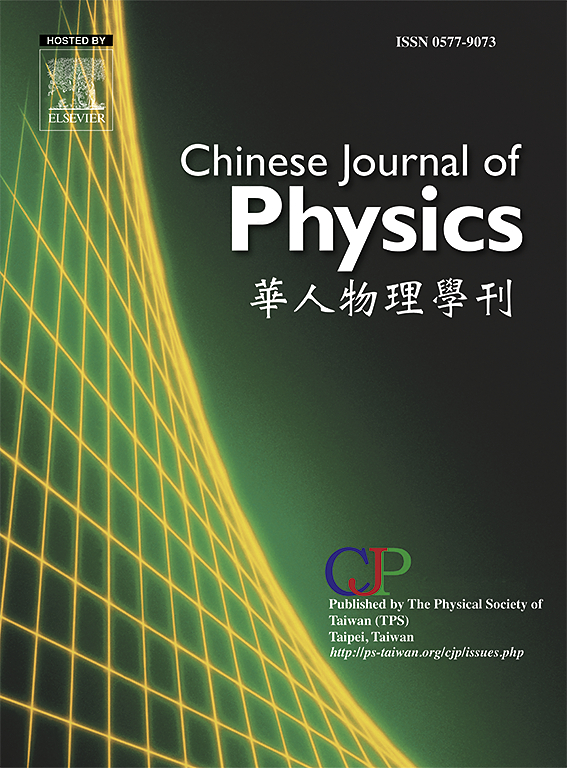Coupled electromagnetohydrodynamic and heterogeneous reactive solute transport in non-Newtonian third-grade fluid flow through a microchannel
IF 4.6
2区 物理与天体物理
Q1 PHYSICS, MULTIDISCIPLINARY
引用次数: 0
Abstract
In this work, we investigated the microfluidic solute dispersion in electromagnetohydrodynamics (EMHD) flow of third-grade fluid in parallel plates microchannel. On account of the complex non-linearity of the Navier-Stokes equation, a series solution is introduced for the derivation of an analytical expression for a velocity distribution. For microscale system design, optimizing surface area and mass transfer efficiency is crucial. Skin friction contours aid in this evaluation. Additionally, the time-dependent convection–diffusion equation is analyzed using Aris’s method of moments to formulate the moment equations, which are solved through an implicit finite difference scheme. The mean concentration distribution of the tracers is calculated using the first four central moments expressed in a Hermite polynomial. Moreover, the two-dimensional concentration distribution is represented using contour plots, with the analysis based on Gill’s work on asymptotic expansions. From our investigation, it is apparent that higher values of the third-grade parameters () improve the non-Newtonian characteristics and result in an obstruction to solute transport in the microchannel. Strong boundary absorption significantly accelerates tracer depletion in the microchannel, leading to an exponential reduction in contaminant retention over time. A higher electric field leads to a strong electroconductive effect to facilitate the mobility and velocity of charged particles that interact intensively with the medium, resulting in increased mixing and improved solute transport. Such a system strongly affects the ion separation process based on both charge and size, so increasing the strength of conduction field separation becomes more efficient. The analysis presents a highly complex understanding of solute dispersion control through a microfluidic system, offering modern application of the mechanism in drug delivery, blood flow, lab-on-a-chip devices, and cell separation.

非牛顿三级流体在微通道中的耦合电磁流体动力学和非均相反应溶质输运
本文研究了平行板微通道中三级流体电磁流体动力学(EMHD)流动中微流体溶质的分散。考虑到Navier-Stokes方程的复杂非线性,引入级数解来推导速度分布的解析表达式。对于微尺度系统的设计,优化表面积和传质效率是至关重要的。皮肤摩擦轮廓有助于这种评估。此外,利用Aris的矩量法对随时间变化的对流扩散方程进行了分析,建立了矩量方程,并用隐式有限差分格式求解。示踪剂的平均浓度分布是用埃尔米特多项式表示的前四个中心矩计算的。此外,利用等高线图表示二维浓度分布,并基于Gill的渐近展开工作进行分析。从我们的研究中可以明显看出,较高的三级参数(σ)值改善了微通道的非牛顿特性,并导致溶质在微通道中的输运受阻。强的边界吸收显著地加速了微通道中示踪剂的耗竭,导致污染物潴留随时间呈指数减少。较高的电场会导致较强的导电效应,从而促进带电粒子的迁移率和速度,这些带电粒子与介质发生强烈的相互作用,从而增加混合和改善溶质输运。这种体系对离子分离过程的影响是基于电荷和尺寸的,因此增加导场分离的强度变得更加有效。该分析通过微流体系统提供了对溶质分散控制的高度复杂的理解,提供了在药物输送,血液流动,芯片实验室设备和细胞分离机制中的现代应用。
本文章由计算机程序翻译,如有差异,请以英文原文为准。
求助全文
约1分钟内获得全文
求助全文
来源期刊

Chinese Journal of Physics
物理-物理:综合
CiteScore
8.50
自引率
10.00%
发文量
361
审稿时长
44 days
期刊介绍:
The Chinese Journal of Physics publishes important advances in various branches in physics, including statistical and biophysical physics, condensed matter physics, atomic/molecular physics, optics, particle physics and nuclear physics.
The editors welcome manuscripts on:
-General Physics: Statistical and Quantum Mechanics, etc.-
Gravitation and Astrophysics-
Elementary Particles and Fields-
Nuclear Physics-
Atomic, Molecular, and Optical Physics-
Quantum Information and Quantum Computation-
Fluid Dynamics, Nonlinear Dynamics, Chaos, and Complex Networks-
Plasma and Beam Physics-
Condensed Matter: Structure, etc.-
Condensed Matter: Electronic Properties, etc.-
Polymer, Soft Matter, Biological, and Interdisciplinary Physics.
CJP publishes regular research papers, feature articles and review papers.
 求助内容:
求助内容: 应助结果提醒方式:
应助结果提醒方式:


